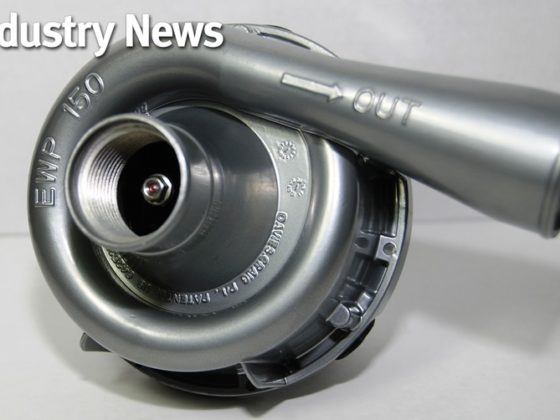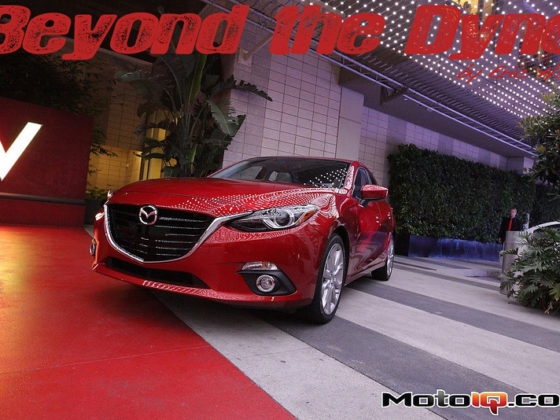,
With the oil pan baffling complete and the engine sealed, it is time to give some attention to the external engine components. The first parts actually fall more into the engine management category than anywhere else, but the crank angle sensor and crank trigger wheel must be installed at this point before the water pump housing and pulleys can be.
Most people don't pay much attention to crank trigger wheels, but it is important when you look at the factory unit. The OEM trigger wheel utilizes a 12+1 arrangement with two variable reluctor crank angle sensors (commonly called magnetic sensors). One sensor reads crank angle 12 times per revolution (once every 30 degrees), while the other senses reference for each rotation.
Full Function Engineering's 60-2 trigger wheel kit replaces the factory setup. A 60-2 trigger wheel has 58 actual teeth spaced 6-degrees apart and a gap where 2 additional teeth would be. That means that the Full Function Engineering (FFE) trigger wheel has six times more resolution than the factory trigger wheel and utilizes the gap in the teeth to reference each rotation of the eccentric shaft. This extra resolution will allow the ECU to control the engine with greater precision.
 Full Function Engineering's 60-2 crank trigger wheel kit with Hall Effect sensor. This trigger wheel gives five times the resolution compared to the factory 12 tooth trigger wheel and includes everything needed to install it to a 13B-REW engine controlled by a capable engine management system.
Full Function Engineering's 60-2 crank trigger wheel kit with Hall Effect sensor. This trigger wheel gives five times the resolution compared to the factory 12 tooth trigger wheel and includes everything needed to install it to a 13B-REW engine controlled by a capable engine management system.Because the FFE trigger wheel uses a gap in the teeth to reference each rotation and the fact that a rotary engine only needs 360 degrees worth of crank angle information for sequential injection and/or direct fire ignition, a single crank angle sensor is used to replace the two factory sensors. In this case, the two variable reluctor sensors are replaced with a single Hall Effect sensor. These two types of sensors operate in significantly different ways, but the important functional difference is that a Hall Effect sensor is less prone to signal interference than a variable reluctor. This can become a problem when the crank angle sensor wiring is run near the ignition system.
 The fit and finish of the FFE trigger wheel kit is top notch. The new crank angle sensor bracket includes a top-dead-center pointer and the trigger wheel itself is marked for TDC as well. Look out for more parts from Full Function Engineering in future articles.
The fit and finish of the FFE trigger wheel kit is top notch. The new crank angle sensor bracket includes a top-dead-center pointer and the trigger wheel itself is marked for TDC as well. Look out for more parts from Full Function Engineering in future articles.Now that the crank trigger wheel and main pulley are installed, the water pump housing, water pump, alternator, and associated pulleys need to be installed. Since this is a track car with many components removed, the pulley system is far from stock. The original system contained two belts; one that drove the main pulley, water pump, alternator, and emissions air pump and another that drove the power steering pump and A/C compressor. Because the air conditioning and power steering have been removed, the accessory belt is not used. The OEM main pulley is nice because it is a two-piece unit that can be separated to facilitate this change. We have also removed the emissions air pump because we are running a large single turbo and an aftermarket ECU. This leaves the main pulley driving a single belt for the water pump and alternator.
 This is the factory belt routing of the 13B-REW. (AP=air pump, WP=water pump, A=alternator, PS=power steering pump, A/C=air conditioning compressor, ENG=engine main pulley).
This is the factory belt routing of the 13B-REW. (AP=air pump, WP=water pump, A=alternator, PS=power steering pump, A/C=air conditioning compressor, ENG=engine main pulley).At this point one might say “Wow that is an extremely simple setup” and while this is technically true, there is still one complication to overcome. With the factory pulley setup the emissions air pump pulls the belt routing away from the centerline of the engine and, in a way, acts like an idler pulley. When you remove the air pump, the route the belt takes is nearly a straight line between the main and alternator pulleys, leaving the water pump with almost zero contact area.
The way many people fix this problem is by increasing the diameter of the water pump and alternator pulleys to break up the straight line and give more contact area to the water pump pulley. This does work to an extent and is how the pulleys were configured on the original build of this car, but it is still not the optimal solution since it underdrives the water pump and alternator in an attempt to engage the water pump pulley.
 This is the old pulley setup that does not include an idler pulley. Notice the small contact area on the water pump pulley and the size of the water pump and alternator pulleys. The lack of traction on the water pump pulley is often overcome by over tensioning the belt which can cause accelerated bearing wear inside the engine. Using these pulleys also underdrives the alternator and water pump.
This is the old pulley setup that does not include an idler pulley. Notice the small contact area on the water pump pulley and the size of the water pump and alternator pulleys. The lack of traction on the water pump pulley is often overcome by over tensioning the belt which can cause accelerated bearing wear inside the engine. Using these pulleys also underdrives the alternator and water pump.The better solution is to implement an actual idler pulley to take the place of the emissions air pump and Pineapple Racing have developed two pulley kits that do just that; one for use with the stock twin turbos or a smaller, more rear mounted single turbo and one for use with a larger single turbo. This project features the latter of the two known as the “BT” (big turbo) model.
 Pineapple Racing's “BT” idler pulley kit is designed to properly route the main engine belt when running a large single turbo. Pineapple Racing has a long history of building quality rotary engines and rotary engine components and their success is easily understood when you look at the quality of their idler pulley kit.
Pineapple Racing's “BT” idler pulley kit is designed to properly route the main engine belt when running a large single turbo. Pineapple Racing has a long history of building quality rotary engines and rotary engine components and their success is easily understood when you look at the quality of their idler pulley kit.
 The new pulley setup with the Pineapple Racing “BT” idler pulley and OEM alternator and water pump pulleys installed. Notice how much more contact area there is between the belt and water pump pulley. Also, the alternator bracket has been modified by removing the “stud to nowhere” that is shown in the picture of the previous build.
The new pulley setup with the Pineapple Racing “BT” idler pulley and OEM alternator and water pump pulleys installed. Notice how much more contact area there is between the belt and water pump pulley. Also, the alternator bracket has been modified by removing the “stud to nowhere” that is shown in the picture of the previous build.There are a great number of things that are often overlooked when building a car, several of which were covered today. With any luck we can avoid as much of that as possible during this build and end up with an awesome RX-7. There is a lot to do and this is only the beginning, so stay tuned for the next update.




1 comment
What apex seals were used in the engine?